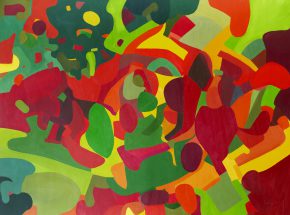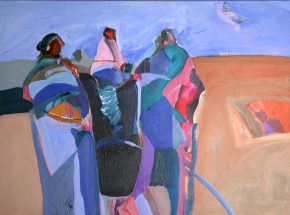

George Earl Ortman (born October 17, 1926) is an American painter, printmaker, constructionist and sculptor. His work has been referred to as Neo-Dada, Pop art, Minimalism, and Hard Edge. His constructions, built with a variety of materials and objects, deal with the exploration off visual language derived from geometry—geometry as symbol and sign.
Ortman was born in Oakland, California. His father was an electrician who learned his trade from his father, George Earl Ortman, who worked with Thomas Edison in Chicago in the late nineteenth century. His mother, born Anna Katherine Noll, was born in Frankfurt Au Main, Germany. She came to the United States in 1914 to work as governess for the mayor of San Rafael, California. After completing high school, Ortman enlisted in the United States Naval Air Corps V-5 program. Upon his discharge in 1946, he studied at the California College of Arts and Crafts (now the California College of the Arts) (1947–1948). After several years, he moved to New York City where he studied at the Atelier 17, a printmaking school founded by the English painter and printmaker Stanley William Hayter (1949). Later that year, he left for Paris where he studied at the Atelier André Lhote (1949–50). Upon his return to New York CIty he studied at the Hans Hofmann School of Fine Arts (1950–51).
Ortman first exhibited in the Salon de Mai in Paris in 1950. Upon his return to New York City he was invited to join the Artist’ Club, a meeting place for artists whose members included early proponents of Action painting and Color Field painting. In 1953 he had his first solo exhibition at the Tanager Gallery, one of the Tenth Street a co-operative galleries that together formed an avant-garde alternative to the more conservative 57th Street and Madison Avenue galleries. In 1954, he and actress Julie Bovasso founded the Tempo Playhouse to perform contemporary European playwrights, including the first American showings of Jean Genet, Eugène Ionesco, and Michel de Ghelderode.
In 1954 and 1960, he showed simplified geometric constructions at the Stable Gallery. This work was viewed by Donald Judd as a precursor to Minimalism.[1] In July 1960 he married the artist, Conni Whidden. In 1965 Ortman was appointed artist in residence at Princeton University, and was honored with a retrospective at the Walker Art Center in Minneapolis.
In 1970 Ortman assumed the position of Head of the Painting Department at Cranbrook Academy of Art in Bloomfield Hills. His wife of 30 years died in 1991. The following year Ortman left Cranbrook. Returning to the East Coast, he moved to Castine, Maine, where he lives and works.
https://en.wikipedia.org/wiki/George_Earl_Ortman



